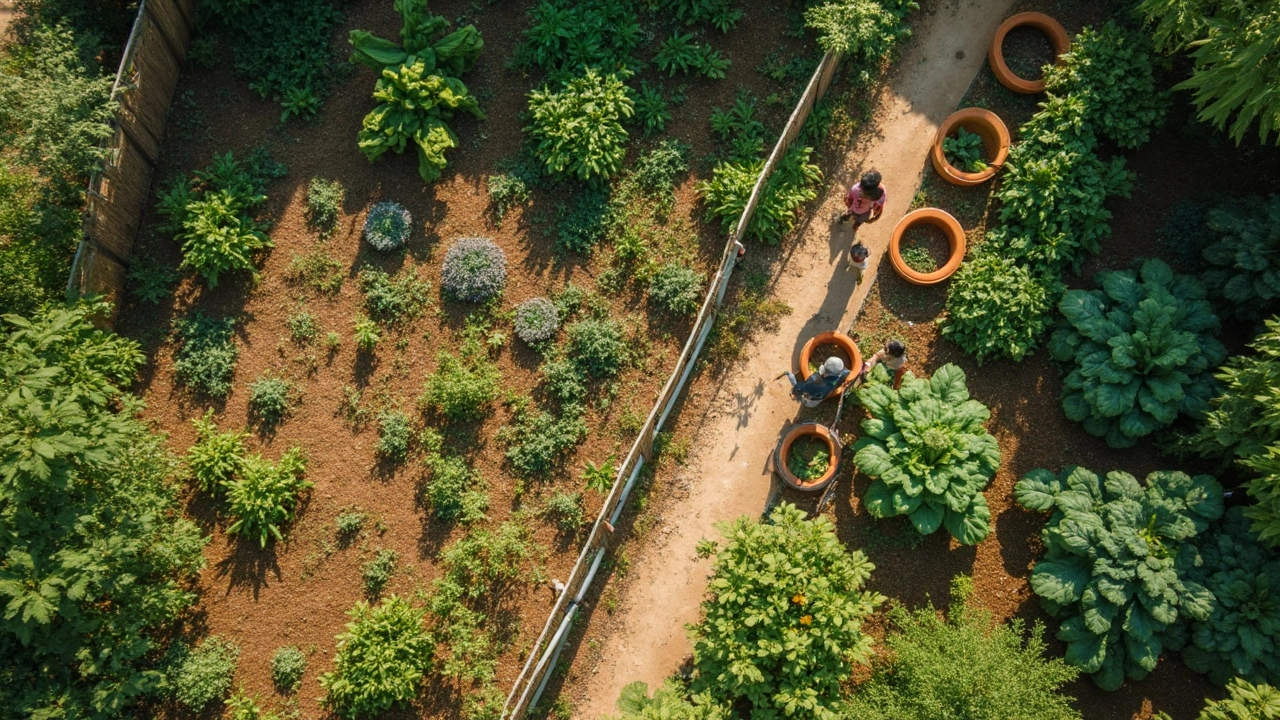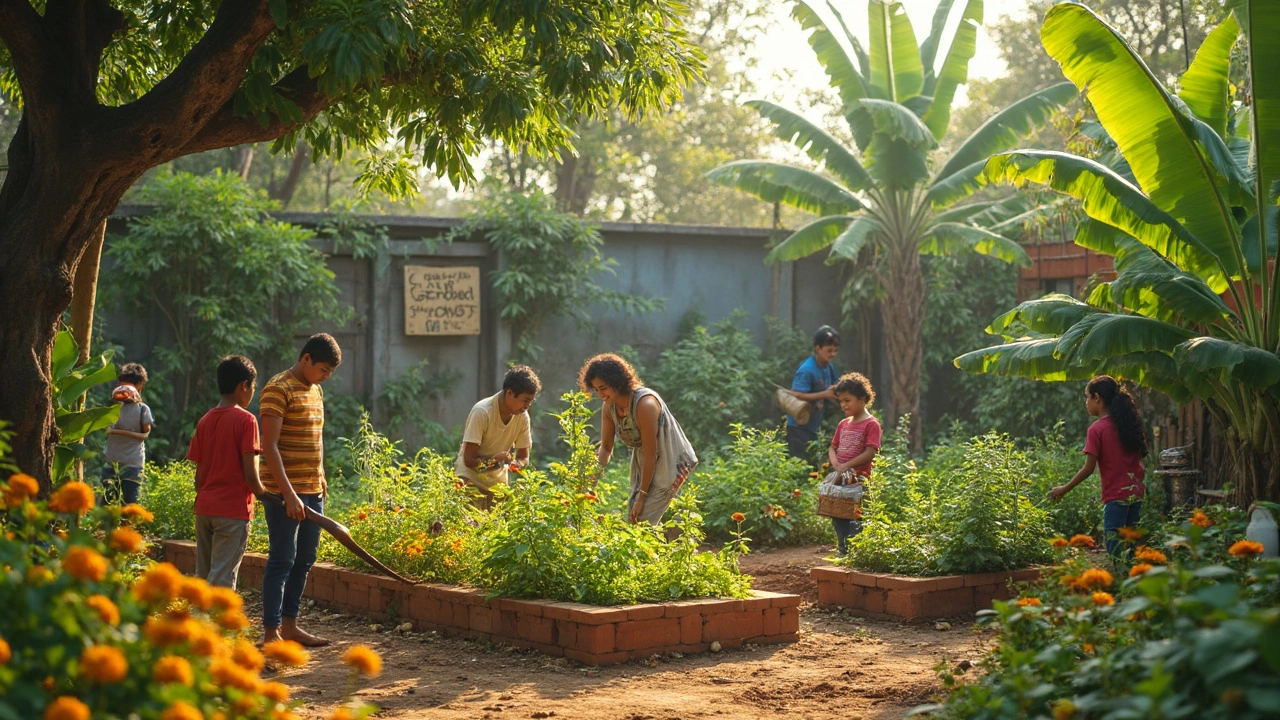If you want a garden that mostly takes care of itself, you’re in good company. A self-sustaining garden means less watering, weeding, and fussing—plus, it saves you money and helps the planet. The trick isn’t getting fancy. It’s getting smart with your setup from the start.
First up, ditch the idea that more work gets better results. Nature likes to handle a lot on its own, if you set the stage right. Creating a garden where soil stays rich, pests don’t take over, and plants get along makes your life way easier. You’ll rely less on harsh chemicals and artificial fertilizers, too.
What does that look like? It’s all about healthy soil, plants that help each other out, and techniques that use water and resources wisely. You’re setting up a system that, once it’s running, keeps going with just basic care.
Sounds good? Let’s look at the key moves that actually make this work—without buying a pile of products you don’t need. Ready to roll up your sleeves? Let’s dig in.
- Kicking Off: What Makes a Garden Self-Sustaining?
- Soil: The Living Foundation
- Water Wisely: Smart Solutions for Every Yard
- Plants That Work Together, Not Against You
- Low-Maintenance Tricks for Lasting Results
Kicking Off: What Makes a Garden Self-Sustaining?
A self-sustaining garden works like a mini ecosystem. It keeps growing, producing food, and staying healthy with almost no outside help. The coolest thing? You’re not throwing bags of fertilizer or chemicals around. Instead, you build up soil life, work with natural cycles, and let good bugs do a chunk of the work.
At the core, these gardens recycle their own nutrients, trap moisture, and keep pests in check without constant attention. You don’t have to reinvent the wheel—just copy what happens in nature. Think forests: nobody goes in there to water, weed, or feed the trees, but everything still thrives. The difference: you’re guiding that process so you actually get tomatoes, lettuce, or flowers along the way.
The big parts that make a garden self-sustaining include:
- Healthy soil: Compost, mulch, and leaving plant roots in the ground feed billions of tiny life forms. These little guys break down dead matter, keep soil loose, and help plants pull in nutrients.
- Right plants: Mix things up! Different plants play different roles—some pull nutrients up, others repel pests, and a few bring in hungry pollinators.
- Efficient water use: Mulching, rain barrels, and drought-tolerant plants mean you don’t have to stand there with a hose every evening.
- Encouraging helpful insects: Ladybugs and bees do way more for you than sprays ever could. Welcome them in and cut back on chemical use.
Here’s a quick breakdown of what it typically takes to keep one going versus a typical backyard garden:
| Self-Sustaining Garden | Traditional Garden | |
|---|---|---|
| Watering Frequency | 1-2 times/week | Daily or every other day |
| Fertilizer Needed | Mostly homemade compost | Store-bought, more often |
| Pest Control | Ladybugs, companion plants | Sprays, powders |
| Weeding | Minimal with thick mulch | Regular (sometimes daily) |
Most people who switch to a setup like this say their garden chores drop by more than half after the first year. Plus, you spend less cash at garden centers.
The bottom line: You’re setting yourself up for fewer hassles and better results once the ball gets rolling. The key? Build strong basics right out of the gate. Soil, water, smart planting, and friendly bugs—those are your four pillars.
Soil: The Living Foundation
If you skip out on soil health, your garden is going to let you know—loudly. Healthy soil isn’t just dirt; it’s packed with microbes, worms, and even fungi, all working together to keep your plants strong. Think of it like a busy underground city that feeds your garden for free, if you take care of it.
According to the USDA’s National Resources Conservation Service, “Soil is not an inert growing medium, but rather is teaming with billions of bacteria, fungi, and other microbes that are the foundation of an elegant symbiotic ecosystem.”
“If you want a sustainable garden, you have to start below ground.” – USDA NRCS
Here’s what really matters if you want a self-sustaining garden:
- Stop tilling so much. Tilling breaks up soil structure and messes with natural critters living in it. Try only loosening the soil where you plant, not turning everything over each season.
- Feed the soil, not just the plants. Instead of dumping chemical fertilizers, add compost, shredded leaves, or well-rotted manure. These boost life in the soil and give long-lasting nutrients.
- Mulch like you mean it. Spread a layer of mulch—straw, bark, or even grass clippings—over bare spots. It locks in moisture, keeps roots cool, and slowly feeds the dirt underneath as it breaks down.
If you’re not sure what your soil needs, grab a simple home test kit. These are cheap at most hardware stores and tell you if you’re missing key basics, like nitrogen or phosphorus. Remember, healthy soil smells earthy—not funky—and it crumbles easily in your hand.
Skip harsh chemicals when you can. The good stuff in compost and mulch encourages those helpful soil critters to stick around, which means healthier plants and less work for you in the long run.

Water Wisely: Smart Solutions for Every Yard
When it comes to self-sustaining gardens, water is a big deal. The less you have to lug out the hose, the better. Most traditional gardens waste tons of water—up to 50% just gets lost to evaporation. With the right moves, you can cut that waste way down and keep your plants happy, even during dry spells.
The first thing that makes a difference? Mulch. A thick layer—think 2-3 inches—of shredded leaves, straw, or wood chips locks in moisture, keeps roots cool, and even smothers out weeds. It’s garden gold, simple as that.
Want to send less water down the drain? Catch rain. Setting up rain barrels to collect water from your roof is cheap, easy, and works almost anywhere. In a lot of places, just one inch of rain on a standard roof can fill a 50-gallon barrel. That’s free water for your garden, no extra effort.
Drip irrigation is another smart move. Unlike sprinklers that spray everywhere, drippers send water straight to plant roots, where it counts. A study out of Texas A&M showed gardens using drip irrigation used at least 30% less water but still got top yields. And for folks short on time, timers make watering even easier. Just set it and forget it.
Not sure how much water your plants actually need? Check out this simple table for daily needs by garden type:
| Garden Type | Water Use (Gallons/sq ft/day) |
|---|---|
| Vegetable beds | 0.5 |
| Flower beds | 0.3 |
| Xeriscape (drought hardy) | 0.1 |
Also, wise gardeners plant smart. Group thirsty plants together and save the driest spots for tough cookies like sage, rosemary, or lavender. Less water, less hassle.
Here’s a quick hit-list for watering smarter, not harder:
- Mulch thickly to hold in water
- Install drip irrigation or soaker hoses
- Use rain barrels to catch and store water
- Water early in the morning to beat evaporation
- Group plants with similar water needs together
If you take away just one thing, here it is: building a self-sustaining garden means making water work for you, not the other way around. More water in the soil, less work for you, healthier plants all season long.
Plants That Work Together, Not Against You
If you want your self-sustaining garden to really work, you need the right plant combos. Some plants are classic teammates—either because they keep bugs away or boost each other’s growth. This magic is called companion planting, and farmers have used it since way before supermarkets were a thing.
Take tomatoes and basil. Grow them close, and you’ll have fewer tomato hornworms plus tastier tomatoes. Beans and corn are another all-star pair: beans fix nitrogen in the soil (basically, make fertilizer), while tall corn gives beans a natural support to climb.
You don’t need charts and apps to get started. Just use these proven combos that do double-duty in most backyards:
- Carrots + onions: The onions chase off carrot flies, while carrots confuse onion flies. They both get healthier.
- Marigolds with almost anything: These bright flowers repel aphids and nematodes. Tuck marigolds in veggie beds and you’ll notice fewer bad bugs.
- Corn + beans + squash (Three Sisters): Native Americans nailed this one hundreds of years ago. Corn supports the beans, beans feed the soil, and squash shades the ground, keeping weeds down and soil moist.
- Cabbage family + dill: Dill calls in the good bugs (like ladybugs and wasps that eat caterpillars), which protects broccoli, cabbage, and kale from hungry larvae.
Skip planting veggies from the same family side by side, since they might fight for nutrients or attract the same pests. For example, don’t fill one bed with only tomatoes, peppers, and eggplants—they’re all nightshades, so they get the same bugs and diseases.
If you’re planting fruit trees or berry bushes, toss some chives or garlic around the base. They help fend off fungal problems and some beetles. Plus, you get bonus herbs at harvest.
This mix-and-match approach isn’t just for old-school gardeners. It works because it mimics what nature does all by itself—a bunch of plants balancing each other out. Less work for you, a healthier garden for your yard.

Low-Maintenance Tricks for Lasting Results
If you're looking for a garden that sticks around and thrives without constant effort, these tricks make the difference. The whole game is setting up systems once so you can mostly relax and just watch things grow.
The secret weapon? Mulch. Tossing wood chips, leaves, or straw on your soil does three things: keeps weeds down, holds in water, and feeds your dirt as it breaks down. A Cornell University study found that gardens with a three-inch mulch layer needed about 50% less watering during a hot summer. That’s a win for your water bill and your time.
- Lay cardboard or newspaper down before mulching if weeds are a big headache. They don’t have a shot after that.
- Re-mulch every spring and fall for the best results. You can use free stuff like grass clippings or even last year’s leaves.
Don’t skip Perennials. Unlike annuals, these plants bounce back year after year. Think herbs like chives, rhubarb, asparagus, and fruit bushes. Less replanting, way easier on your schedule.
Keep your self-sustaining garden running with a compost system. It’s cheaper and more effective than bagged fertilizer. Toss in kitchen scraps, coffee grounds, lawn clippings, and shredded paper. Avoid meat and dairy unless you like critter problems. Compost can slash household food waste by over 30%, according to EPA data. Here’s a handy cheat sheet:
| Material | Time to Break Down | Notes |
|---|---|---|
| Fruit & Veggie Scraps | 2-6 months | Chop small for quicker results |
| Eggshells | 6-12 months | Crush for faster breakdown |
| Grass Clippings | 3-6 months | Mix with dry stuff |
| Leaves | 6-18 months | Shred if possible |
| Shredded Paper/Cardboard | 2-6 months | Avoid glossy print |
Group your thirsty plants together, and shade their roots with big-leafed friends. That little trick means you don’t run around with a hose as often. Drip irrigation or soaker hoses help too—they use around 30% less water than sprinklers, according to the EPA.
Last, set up a rain barrel. Most homeowners can collect about 600 gallons from just one inch of rainfall off a 1,000-square-foot roof. That’s a lot of free water for dry spells, and it takes maybe half an hour to set up the basics.
- Add native plants—they need less water and rarely get weird diseases.
- Start small and expand your garden as you figure out what works in your yard.
- Walk your garden once a week. You’ll catch problems early, but most weeks, you’ll just enjoy seeing what’s popping up.
The right start pays you back with years of easy food, flowers, and chill weekends in the yard.





